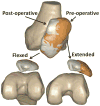Biomechanical Analysis of Tibial Tuberosity Medialization and Medial Patellofemoral Ligament Reconstruction
- PMID: 28459747
- PMCID: PMC5412728
- DOI: 10.1097/JSA.0000000000000152
Biomechanical Analysis of Tibial Tuberosity Medialization and Medial Patellofemoral Ligament Reconstruction
Abstract
Biomechanical studies are commonly performed to evaluate the influence of medial patellofemoral ligament (MPFL) reconstruction and tibial tuberosity medialization on patellar tracking and patellofemoral contact pressures. The most common method is in vitro simulation of knee function, but computational simulation of knee function and computational reconstruction of in vivo motion can also be utilized. The current review of the biomechanical literature indicates that MPFL reconstruction and tibial tuberosity medialization reduce lateral patellar tracking. Decreased lateral patellofemoral contact pressures have also been noted. For MPFL reconstruction, the most commonly noted biomechanical concerns are graft overtensioning and nonanatomic attachment on the femur leading to overconstraint of the patella and elevated medial contact pressures. For tuberosity medialization, the influence of altered tibiofemoral kinematics on postoperative function is unknown. Future biomechanical studies should emphasize inclusion of anatomic features and tracking patterns related to patellar instability, with comparison between the surgical approaches for continued development of treatment guidelines.
Conflict of interest statement
Conflicts of Interest: None are declared for the remaining authors.
Figures



Similar articles
-
The ability of medial patellofemoral ligament reconstruction to correct patellar kinematics and contact mechanics in the presence of a lateralized tibial tubercle.Am J Sports Med. 2015 Sep;43(9):2198-207. doi: 10.1177/0363546515597906. Epub 2015 Aug 19. Am J Sports Med. 2015. PMID: 26290576
-
The effect of femoral tunnel position and graft tension on patellar contact mechanics and kinematics after medial patellofemoral ligament reconstruction.Am J Sports Med. 2014 Feb;42(2):364-72. doi: 10.1177/0363546513509230. Epub 2013 Nov 25. Am J Sports Med. 2014. PMID: 24275861
-
The effect of tibial tuberosity medialization and lateralization on patellofemoral joint kinematics, contact mechanics, and stability.Am J Sports Med. 2015 Jan;43(1):186-94. doi: 10.1177/0363546514554553. Epub 2014 Nov 3. Am J Sports Med. 2015. PMID: 25367019
-
Properties and Function of the Medial Patellofemoral Ligament: A Systematic Review.Am J Sports Med. 2020 Mar;48(3):754-766. doi: 10.1177/0363546519841304. Epub 2019 May 15. Am J Sports Med. 2020. PMID: 31091114
-
Medial patellotibial ligament and medial patellomeniscal ligament: anatomy, imaging, biomechanics, and clinical review.Knee Surg Sports Traumatol Arthrosc. 2018 Mar;26(3):685-696. doi: 10.1007/s00167-017-4469-y. Epub 2017 Mar 13. Knee Surg Sports Traumatol Arthrosc. 2018. PMID: 28289819 Review.
Cited by
-
Tibial Tubercle Anteromedialization Using the Multi-Directional Tibial Tubercle Transfer System.Video J Sports Med. 2024 Jun 13;4(3):26350254241227439. doi: 10.1177/26350254241227439. eCollection 2024 May-Jun. Video J Sports Med. 2024. PMID: 40308522 Free PMC article.
-
Medial patellofemoral ligament reconstruction with or without tibial tubercle transfer is an effective treatment for patellofemoral instability.Knee Surg Sports Traumatol Arthrosc. 2019 Mar;27(3):805-813. doi: 10.1007/s00167-018-5102-4. Epub 2018 Aug 28. Knee Surg Sports Traumatol Arthrosc. 2019. PMID: 30167754
-
Results of medial patellofemoral ligament reconstruction with and without tibial tubercle osteotomy in patellar instability: a systematic review and single-arm meta-analysis.BMC Musculoskelet Disord. 2024 Aug 14;25(1):642. doi: 10.1186/s12891-024-07722-5. BMC Musculoskelet Disord. 2024. PMID: 39143601 Free PMC article.
-
Surgical management of patellofemoral instability part 2: post-operative imaging.Skeletal Radiol. 2019 Jul;48(7):1001-1009. doi: 10.1007/s00256-018-3091-5. Epub 2018 Oct 20. Skeletal Radiol. 2019. PMID: 30341714 Review.
-
Results of Medial Patellofemoral Ligament Reconstruction with and without Tibial Tubercle Transfer in Patellar Instability: A Systematic Review and Meta-Analysis.Orthop Surg. 2023 Nov;15(11):2766-2776. doi: 10.1111/os.13870. Epub 2023 Sep 9. Orthop Surg. 2023. PMID: 37688429 Free PMC article.
References
-
- Weber AE, Nathani A, Dines JS, et al. An algorithmic approach to the management of recurrent lateral patellar dislocation. J Bone Joint Surg Am. 2016;98:417–27. - PubMed
-
- Pritsch T, Haim A, Arbel R, et al. Tailored tibial tubercle transfer for patellofemoral malalignment: analysis of clinical outcomes. Knee Surg Sports Traumatol Arthrosc. 2007;15:994–1002. - PubMed
-
- Sherman SL, Erickson BJ, Cvetanovich GL, et al. Tibial tuberosity osteotomy: indications, techniques, and outcomes. Am J Sports Med. 2014;42:2006–17. - PubMed
-
- Schöttle PB, Schmeling A, Rosenstiel N, et al. Radiographic landmarks for femoral tunnel placement in medial patellofemoral ligament reconstruction. Am J Sports Med. 2007;35:801–4. - PubMed
-
- Stephen JM, Lumpaopong P, Deehan DJ, et al. The medial patellofemoral ligament: location of femoral attachment and length change patterns resulting from anatomic and nonanatomic attachments. Am J Sports Med. 2012;40:1871–9. - PubMed
Publication types
MeSH terms
Grants and funding
LinkOut - more resources
Full Text Sources
Other Literature Sources

